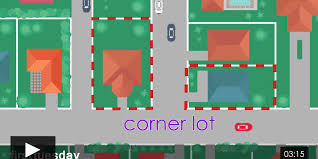
What do you think about corner lots, are they good or bad?
The answer may depend upon the municipality and when the lot was created.
100 Years Ago
Originally, land was subdivided into lots which were all of the same size. That caused a little bit of a problem if you had a corner lot. One side of your property was very accessible to the public and you lost your privacy. But, that was 100 years ago!
50 years Ago
About 50 years ago, with the advent of urban planning and design as a profession, a new breed of subdivisions started to sweep through North American cities. These new subdivisions included courts, crescents and winding roadways that took the long way through the subdivision. There was certainly far less traffic than the vertical and horizontal grids that had been laid out previously in the downtowns.
It would be common to find a subdivision comprised of 50 foot lots, with the corner lot having an additional 20 feet to make it a 70 foot lot.
The Wide Corner Lot
In residential neighbourhoods, the house could be sited on two different streets. The first one with regular width, and the second one along the adjoining street using the depth of the lot as the width of the house. This made the house look very attractive. It left more room for the Architect to use detailing in the design. A wide house generally looks better and is architecturally more appealing than a narrow house.
A Larger House
Often, a larger home would be constructed. The total size of the house is usually based on the size of the lot. In an area which permits 30% coverage, a house of 2,250 square feet can be constructed on a regular 50’ x 150’ lot, but a house of 3,150 square feet, can be erected on a 70’ x 150’ l corner lot. This makes a big difference!
Privacy Issues
Architects and builders will often take advantage of the corner lot for increased setbacks and configure designs to permit additional privacy.
This is going to cost some money. Heavy landscaping, sizeable bushes and trees but ultimately more privacy is achieved. This is an added expense, but it can pay off.
Sight Triangle
Then, there’s the sight triangle. Car accidents usually take place at intersections, and in residential subdivisions they occur because drivers can’t see around the corner. So, the solution is the sight triangle. At the corner of an intersection the municipality will create a strip of property which is reserved for municipal purposes. You can’t build upon it, or obstruct it in any way. This creates a setback and allows drivers to see one another.
The bonus is that this extra piece of property looks like it’s part of the corner. Bushes and trees are not permitted, nor are fences or sheds, but flowers and grass are fine. So, now the 70 foot lot looks like it’s 85’ in width. This is quite noticeable in suburbs where 50’ lots are the norm.
As well, some municipalities will forgo the sidewalk along one side of a corner lot. Again, this increases the apparent setback from the roadway and provides more space.
When you go back to the older downtown areas of major cities, the corner lot was often the least desirable house in the neighbourhood, but in the newer areas, these same locations were bonussed with additional land and were adjacent to municipal easements that made these lots among the most prestigious in the area. And, they often represent excellent value!
Brian Madigan LL.B., Broker
